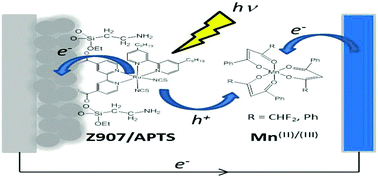On the stability of manganese tris(β-diketonate) complexes as redox mediators in DSSCs†
Abstract
The photoelectrochemical properties and stability of dye sensitized solar cells containing Mn(β-diketonato)3 complexes, [MnIII(acac)3] (1) (acac = acetylacetonate), [MnIII(CF2)3] (2) (CF2 = 4,4-difluoro-1-phenylbutanate-1,3-dione), [MnIII(DBM)3] (3) (DBM = dibenzoylmethanate), [MnII(CF2)3]TBA (TBA = tetrabutylammonium) (4) and [MnII(DBM)3]TBA (5), have been evaluated. At room temperature, the complexes undergo ligand exchange with 4-tert-butyl-pyridine, an additive commonly used in the solar device to reduce charge recombination at the photoanode. An increased device stability was achieved by using the Z907 dye and passivating the photoanode with short chain siloxanes. It was also found that the Mn(II)/(III) couple is involved in the dye regeneration process, instead of Mn(III)/(IV) (E1/2 > 1 V vs. SCE) previously indicated in the literature.


 Please wait while we load your content...
Please wait while we load your content...